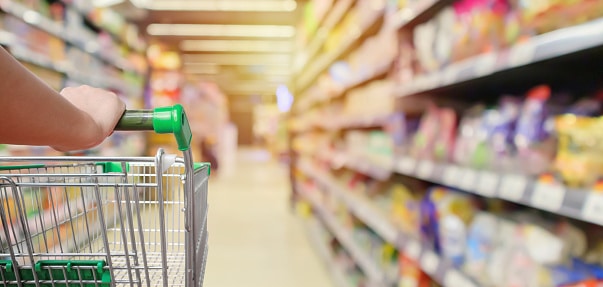How to Leverage Data and Technology to Keep Shoppers Coming Back

The far-reaching impact of digital transformation is typically associated with the digital-first preferences of millennials (or “Generation Z”). However, we were recently startled to see that Gen X grocery shoppers are now trending toward online services more than ever before. If we see even a modicum of shift among the even larger Baby Boomer generation, this begs the question: Are the days of the brick-and-mortar neighborhood grocery stores counting down?

They are not. Like the much-ballyhooed but unmaterialized “retail apocalypse” shows us, grocery stores are here to stay. However, it would not be a stretch to say that they’re soon going to look like nothing we’ve ever seen before.
Like retail shoppers who have been conditioned to the expediency of online options, grocery shoppers are also demanding seamless experiences – experiences that don’t involve long check-out lines, extensive searches through the aisles, disorganized shelves, or out-of-stock inventory.
So, what can we expect? It’s likely that “click-and-pick-up” ordering formats and delivery services will become increasingly popular, along with mobile apps and digital displays in-store. A Russian inventor has even patented a new concept for a drive-through grocery store in which customers can drive right up to their aisle of choice, choosing from a variety of items presented on slowly-rotating shelves.
Mobile payment at check-out – with automated, self-checkout kiosks – will become the new standard (say goodbye to your grandmother’s beloved paper coupons). Or perhaps, with the advancement of artificial intelligence and facial recognition software, the very idea of checkout lines may disappear altogether.
Digital Augments (Not Replaces) the Grocery Store Shopping Experience
While some doom-and-gloomers may still forecast the demise of brick-and-mortar grocery stores, studies have shown that the majority of shoppers still prefer getting their groceries in these physical environments. In stores, customers can pick up and examine items in person, enjoy a cup of coffee while browsing, and take in the sights and smells of the fresh food items as they go – perhaps even snacking on samples or watching a cooking demonstration.
These encounters combine to create a powerful first-hand impression. If the store pulls it off with an inviting, organized environment and streamlined interface, customers will keep coming back – and may even choose your store over nearby competitors as their weekly grocery destination.
Especially on the heels of the recent $13.7 billion Whole Foods acquisition by Amazon in 2017, grocers must look to data and technology as a mandatory investment – not only to optimize the customer experience, but also to remain culturally relevant against competitors.
The following are three rapidly-evolving technologies that all grocers should be leveraging in order to continue to grow and retain loyal customers:
1. Service Automation
Facilities data, in many ways, serves as the foundation for an efficient and streamlined grocery shopping experience: The amount and type of space available, the number of employees and end-users, temperature and air quality metrics, cleaning and maintenance reports, and asset performance are all examples of the data that underlies a functional grocery infrastructure. While this kind of data has been underutilized in recent years, new technology is now available to make it more actionable for facilities managers, directors, and operations executives.
A grocery store that isn’t properly maintained is the fastest way to send customers running. Even a malfunctioning light fixture or refrigerator outage can create a memorable impression – and not the positive kind. For this reason, stores must be cognizant of asset maintenance and develop a strategy that hinges on preventative upkeep as opposed to reactive efforts (like scrambling to fix a leaking freezer after hundreds of dollars of merchandise has already been spoiled).
In addition, many retailers are now moving towards prepared foods and ready-to-make meals as a substantial segment of their revenue. These items carry a much higher margin than traditional groceries; on the flip side, however, they tend to increase customer expectations around cleanliness (compared to the expectations perceived when purchasing canned goods or packaged foods, for instance). Any instance of poor store hygiene – such as flickering lights, missing floor tiles, or a dirty bathroom – will seriously hurt consumer impressions, much in the same way as it would in a restaurant environment.
A service automation platform serves as a centralized resource for facilities managers and operational directors to keep track of assets and performance, 24/7. Rather than manually submitting work orders or tracking invoices in a spreadsheet, grocery store facilities directors will benefit from streamlined work order submissions, payment, and approvals, as well as a comprehensive asset management platform to better utilize maintenance budgets.
Furthermore, service automation technology helps grocers find experienced contractors who are capable of performing high-quality maintenance on specialized equipment unique to the grocery industry – such as refrigerators, freezers, produce irrigation systems, and self-checkout machines.
Refrigerators and freezers alone require carefully planned maintenance in order to maintain regulatory compliance. Grocery stores that fail to monitor refrigerant leakage can easily be subjected to thousands of dollars in fines due to insufficient EPA compliance (not to mention the lost revenue due to refrigerator downtime).
A robust service automation platform will solve these problems by providing a system through which to track and manage refrigerator assets, automating the data collection process and generating regular reports on leakage thresholds.
2. Mobile Technology
Mobile apps and technology are a great way to put useful information directly into the hands of shoppers (and store managers), no matter where they are or what they’re doing.
Many large chain grocers have already developed mobile apps that link to shoppers’ loyalty cards, digital coupons, and even offer mobile payment formats for convenient in-store use. Some apps also include a guide with which to quickly locate specific, hard-to-find items by way of GPS location (such as Walmart’s Store Assistant feature). Others, like Kroger’s ClickList, allow customers to shop and pay for items through the app and pick them up outside the store at a designated time.
Mobile apps provide customers (who are often multitasking, managing young children, or in a hurry) a quick, easy-to-access resource to make the notoriously chaotic Sunday grocery trip a little less hectic. They’re a critical component to the omnichannel shopping experience that modern grocers strive towards – a link between the physical store and its growing digital presence.
Soon, these multi-featured mobile grocery apps are going to become an industry standard: Stores that don’t begin to integrate these features will lose customers to other, more technologically advanced competitors that offer the convenience of mobile interfacing.
On the back end, apps also serve as a valuable central hub for grocery store managers, facilities directors, and employees to gain insight around inventory and store performance. Mobile facilities management apps integrate with digital FM and service automation platforms, allowing users – the store employees and managers who are usually on their feet all day – easy access to work orders, service scheduling, and asset reports.
Other types of mobile apps integrate seamlessly with grocery inventory control software and POS systems, simplifying the already-complex ordering process of an extremely large, varied, and perishable selection of goods.
3. AI and ML
Artificial Intelligence (AI) and Machine Learning (ML) are major buzzwords across the retail industry in this day and age – and for good reason. These technologies provide the framework for advanced automation, allowing grocery stores to save money by handing over the responsibility of routine, mundane (read: time-consuming) tasks to sophisticated computer-driven machines.

With predictive – and even prescriptive – modeling capabilities, AI-enabled technology can make real-time business decisions based on a comprehensive analysis of historical data. This makes tasks like pricing items, approving work orders, and managing inventory a whole lot easier for grocers of all sizes.
AI and its underlying function, ML, can be applied and integrated into many distinct elements of the grocery store business – everything from asset maintenance and work order approval (on the FM side) to sourcing, planning promotions, and distribution. Major retailers including Target and Whole Foods have already begun to integrate Machine Learning to streamline their supply chain and fulfillment system, driving towards an innovative “order-to-shelf” model that allows items to be restocked almost as soon as they leave the shelves.
This precise system eliminates the need for a storage room or warehouse: Instead, ML technology helps stores generate an exact count of the number of items that need restocking based on systematic demand forecasting and real-time data. Shipments are then streamlined in accordance with this information.
How does AI impact customer experience, though?
While back-end processes such as ordering and fulfillment may not be immediately evident to shoppers, a constant supply of fresh, seasonal produce and fully-stocked shelves will be. So will competitive prices and a wide variety of weekly sales, all of which can be optimized for maximum competitive value through AI and ML.
These capabilities are only the tip of the iceberg when it comes to the benefits AI can bring to the grocery industry – we’re bound to see plenty more stores like Walmart’s recently-opened, AI-powered “IRL (Intelligent Retail Lab)” soon popping up across the nation.
Final Thoughts
In order to succeed in this age of digital innovation, grocery stores need to embrace data and technology to provide a memorable customer experience. Customer expectations, as we’ve seen, are rising: A seamless, omnichannel shopping experience is about to be the new norm, and inconveniences such as out-of-stock products, dirty aisles, and long checkout lines are not likely to be tolerated by coming generations. Grocers must therefore invest in technology that allows them to leverage their data across the board – not just their sales and inventory reports.
Facilities data and an efficient, proactive facilities management program are foundational elements to a successful grocery store experience. A service automation platform, combined with advanced mobile technology and AI-powered analytics, will allow grocers to gain actionable insights from their store data that open up new opportunities for improvement. These improvements are critical in keeping the neighborhood grocery store relevant in the digital age – and here to stay for shoppers of any age or generation.



